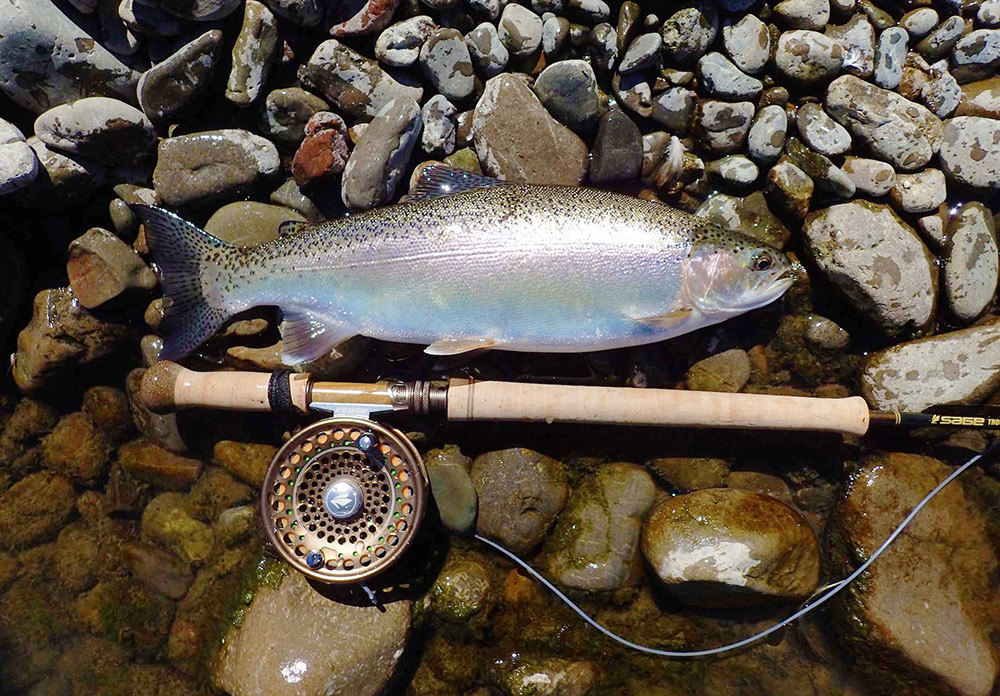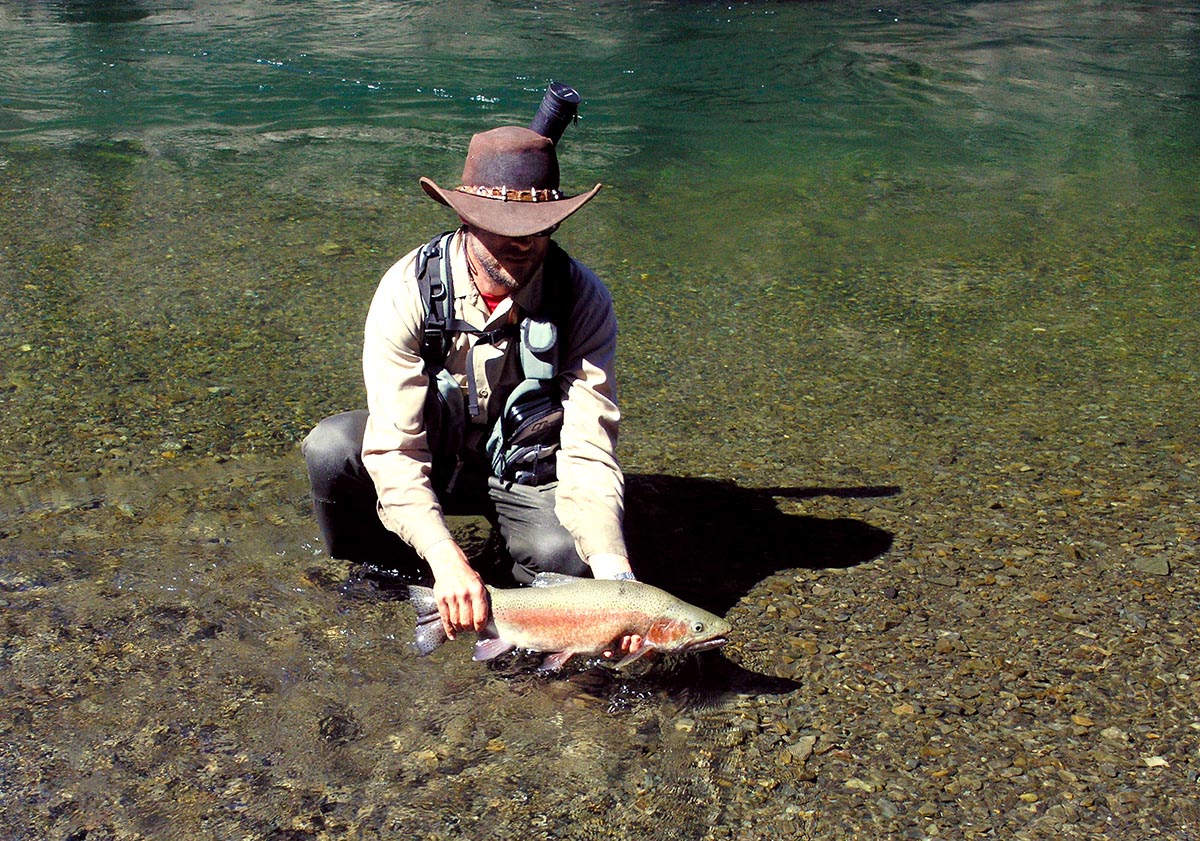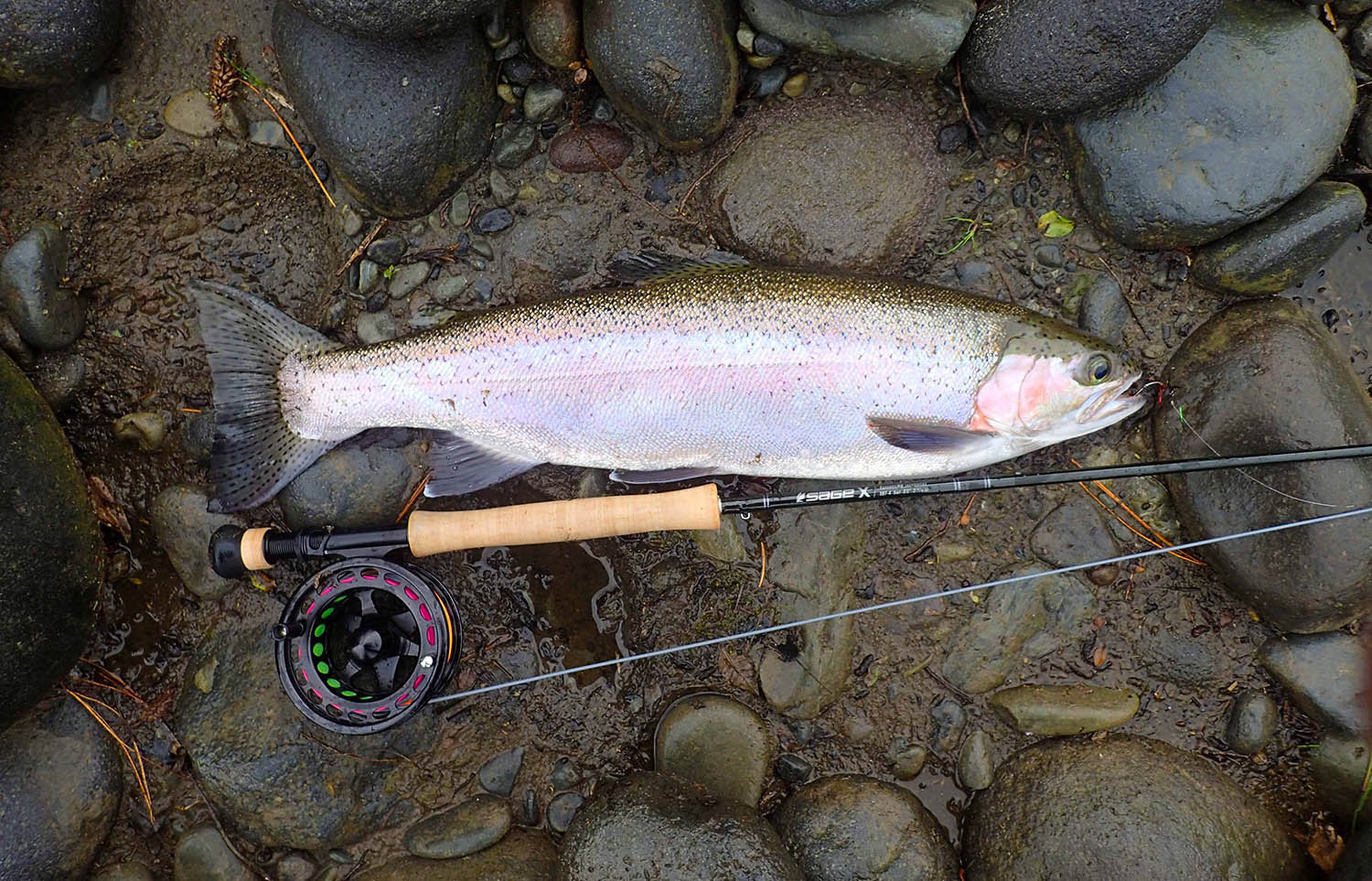In New Zealand, Rainbow trout are not as widely distributed as brown trout, and rainbow trout don’t live in estuaries or the sea. However, rainbow trout have given rise to unique and outstanding fisheries in some rivers and many lakes.
‘River Resident’ Rainbows
New Zealand river-resident rainbows are usually found in the lowland parts of rivers, while brown trout tend to dominate in the headwaters - although notable exceptions are the Rangitikei, Ruakituri and Ngauroro rivers, where rainbow trout also live in the upper reaches.
In lowland rivers containing both brown and rainbow trout, rainbow trout are usually more abundant but on average are smaller in size, averaging 2-3 lbs. These rainbows are successfully fished with techniques I outline in my article about brown trout in New Zealand.

One of many fat rainbows caught swinging streamers on a large lowland river one Autumn day
Rainbows tend to live in faster water than brown trout do, and will often move a lot further to seize a nymph. While the golden rule for nymphing on backcountry rivers is to cast only to sighted fish, prospecting opaque white water runs is often productive on rivers inhabited by rainbows.
Rainbows are generally easier to catch than brown trout, but once exposed to fishing pressure, backcountry rainbows soon wise up and can become equally frustrating.

A decent backcountry rainbow
Lake Resident Rainbows
Deep Lakes
New Zealand rainbow trout have a Californian steelhead pedigree, and those found in deep lakes have a life-style identical to the steelhead of the North American Great Lakes. Lake Taupo rainbows also have the chrome silver flanks and dark blue backs, not to mention a shared partiality for Globugs in winter.
Rainbow trout were introduced to the Great Lakes of North America during the late 1870s and early 1880s, choosing a life-style that emulated sea-run fish, known as steelhead. These fish spend most of their lives offshore, feeding on pelagic baitfish, and returning to their natal (birth) rivers to spawn. Using the lakes in the same way that sea-run rainbows use the sea, and given their silvery flanks and dark blue backs, have also become known as steelhead.
This important fishery has led to the Great Lakes catchments being called the Third Coast by steelhead fisherman.

Rainbow trout in large deep lakes - such as Lakes Taupo, Rotorua, Waikaremoana, Wakatipu, Wanaka and Hawea - spend most of their time offshore in the pelagic zone, where they feed on smelt, in the North Island, or whitebait, in the South Island.
Rainbow trout in these lakes are mostly fished by trolling or jigging from boats, or fly fishing around rivers mouths, using streamers, especially at night. Flies that have luminescent materials charged with head torches, are effective for night fishing for New Zealand rainbows.
A small (size 10) black booby fly with a luminescent body fished on a high density line with a short leader is a reliable fish taker at stream mouths. A white booby with a bit of flash is a good choice during the day.
In October to December many Lake Taupo rainbows follow spawning smelt into shallow bays and stream mouths. Wading the shoreline and casting at large trout tearing into schools of baitfish is as exciting as it is unique.
The movement inshore of white bait (koaro larvae) from March through to May, creates similar excitement at the stream mouths of many South Island lakes.
Steelhead running up Lake Taupo’s tributaries, notably the iconic Tongariro River, are an important and unique fishery. Anglers come from far and wide to thrash these strong waters with heavy nymphs, globugs and indicators resembling small tropical birds.
Splashy casting, multiple hook-ups and powerful fish are certainly not for the faint hearted. But experiencing the rush of that first fresh-run fish, many find themselves hooked.
Migrating Tongariro rainbow trout are also susceptible to taking swinging streamers, so are an exciting target for Trout Spey anglers addicted to the tug.
Even though most steelhead swim into Lake Taupo tributaries in winter and early spring, fresh-run steelhead are caught in the Tongariro throughout the year, and in summer these fish may also be taken during their explosive evening rises to caddis flies.
The average size of Tongariro steelhead can vary substantially from one year to the next, but is usually three to four pounds, with a few fives and the odd six pounder.
Schools of silver rainbow trout enter the tributaries of other deep New Zealand lakes, but since many of these streams are closed during winter, most of the shore-based winter fishing takes place at the stream mouths.
When the trout season re-opens in spring, the tributaries of some large lakes still have huge numbers of rainbow trout, recovering from spawning, and these rivers are popular with anglers wanting to catch high numbers of fish amongst magnificent scenery, e.g. the Greenstone River on Lake Wakatipu.
Shallow Lakes
Rainbow trout in shallow lakes without smelt populations, like Lakes Aniwhenua and Otamangakau, feed within the littoral zone, which is any area shallow enough to support the growth of aquatic vegetation.
In lakes containing both trout species, the shallow littoral zone (1-5 m) is dominated by large brown trout during the day. Under cover of darkness, when brown trout are less aggressive, rainbows move from the deep littoral to the shallow littoral zones
The fishing methods for shallow lakes are similar for both brown and rainbow trout, and are described briefly in my article on brown trout.
Why are there no sea-run rainbows in New Zealand?
Although it was once believed that sea-run and river-resident rainbow trout were two distinct species, it’s been firmly established that they are the same species, Oncorhynchus mykiss.
We also now know that some offspring of steelhead adults become river-resident rainbows, and some offspring of river-resident adults take up a sea-going life-style.
Several rivers on the North and South Islands that flow directly into the sea, contain rainbow trout and these trout are of Californian steelhead stock. One cannot help wonder why there are no sea-run rainbow trout populations in New Zealand - especially since all these rivers have sizeable populations of sea-run brown trout.
The answer could lie in the distance that rainbows move offshore when in the sea.
Several trout and salmon species were introduced into New Zealand waters, but only brown trout (Salmo trutta) and king salmon (Oncorhynchus tshawytsha) have successful sea-going populations.
Both these species remain close to the coast where they are regularly taken by recreational and commercial fishing.
Steelhead, on the other hand, appear to move a lot further from the coast. In North America, for example, steelhead are almost never caught off the coast by commercial salmon fishermen.
Another interesting observation is that New Zealand rainbow trout do not form estuarine populations, as New Zealand brown trout do.
It’s possible some New Zealand rainbow trout do wander out to sea but that offshore waters don’t provide a suitable habitat for them. There may be not enough food, too many predators, or the island current patterns are too complex for these adventurous fish to find their way back to their home rivers.
Subscribe to receive emails about future articles.
